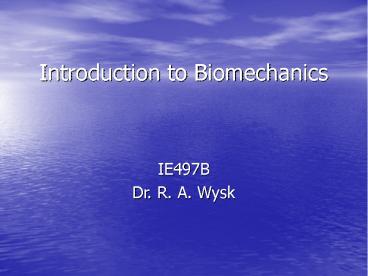Introduction to Biomechanics - PowerPoint PPT Presentation
Title:
Introduction to Biomechanics
Description:
Introduction to Biomechanics IE497B Dr. R. A. Wysk The human skeleton Bone components Cortical Bone Osteonal Bone Joints Fibrous Fibrous joints connect bones without ... – PowerPoint PPT presentation
Number of Views:654
Avg rating:3.0/5.0
Title: Introduction to Biomechanics
1
Introduction to Biomechanics
- IE497B
- Dr. R. A. Wysk
2
(No Transcript)
3
(No Transcript)
4
(No Transcript)
5
(No Transcript)
6
(No Transcript)
7
The human skeleton
8
(No Transcript)
9
(No Transcript)
10
Bone components
11
Cortical Bone
12
Osteonal Bone
13
(No Transcript)
14
(No Transcript)
15
Joints
- Fibrous
- Fibrous joints connect bones without allowing any
movement. The bones of your skull and pelvis are
held together by fibrous joints. The union of the
spinous processes and vertebrae are fibrous
joints. - Cartilaginous
- Cartilaginous joints are joints in which the
bones are attached by cartilage. These joints
allow for only a little movment, such as in the
spine or ribs. - Synovial
- Synovial joints allow for much more movement than
cartilaginous joints. Cavaties between bones in
synovial joints are filled with synovial fluid.
This fluid helps lubricate and protect the bones.
Bursa sacks contain the synovial fluid.
16
17
Synovial Joints
- Synovial joints allow for much more movement than
cartilaginous joints. Cavaties between bones in
synovial joints are filled with synovial fluid.
This fluid helps lubricate and protect the bones.
Bursa sacks contain the synovial fluid.
18
(No Transcript)
19
Ball and socket Joints
- A ball and socket joint allows for radial movment
in almost any direction. They are found in the
hips and shoulders.
20
Ellipsoid Joints
- Similar to a ball and socket joint -- allow the
same type of movement to a lesser magnitude. The
wrist is an ellipsoid joint.
21
Saddle Joints
- A saddle joint allows movement back and forth and
up and down, but does not allow for rotation like
a ball and socket joint.
22
Pivot Joints
- Pivot joints allow rotation around an axis. The
neck and forearms have pivot joints. In the neck
the occipital bone spins over the top of the
axis. In the forearms the radius and ulna twist
around each other.
23
Gliding
- In a gliding or plane joint bones slide past each
other. Metacarpal and metatarsal joints are
gliding joints
24
The knee
25
A bad joint?!?
- 30-50 of all sports injuries
- 0.2 of the general population per year for knee
ligament problems - ACL and MCL are 90 of all sport injuries
- Women are 2-8 times greater risk
26
Long bone
27
Long bone contd
28
(No Transcript)
29
(No Transcript)
30
(No Transcript)
31
(No Transcript)
32
(No Transcript)
33
(No Transcript)
34
(No Transcript)
35
(No Transcript)
36
(No Transcript)
37
Summary
- Human body is a very complex system
- Bones are very strong mechanical members
- Self healing
- Can be very slippery































